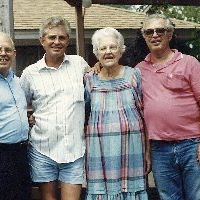Curtis W Stover
age ~60
from Mason, OH
- Also known as:
-
- Curtis Te Stover
- Curtis A Stover
- Curtis V Stover
- Curt W Stover
- Curtis W Stoner
- Sara Stover
- Phone and address:
-
7687 Hedgewood Cir, Mason, OH 45040
(513)5730287
Curtis Stover Phones & Addresses
- 7687 Hedgewood Cir, Mason, OH 45040 • (513)5730287
- 5372 Heather Cir, Mason, OH 45040 • (513)4599472
- West Chester, OH
- Treynor, IA
- Loveland, OH
- Warren, OH
- Butler, OH
- Lebanon, OH
- 8123 Squirrel Hollow Rdg, West Chester, OH 45069 • (513)3652355
Work
-
Company:Ge healthcare
-
Position:Consulting engineer
Education
-
Degree:Bachelors, Bachelor of Science
-
School / High School:Iowa State University1989
-
Specialities:Aerospace Engineering
Emails
Industries
Aviation & Aerospace
Us Patents
-
Compressor Rotor Cooling System For A Gas Turbine
view source -
US Patent:56851588, Nov 11, 1997
-
Filed:Mar 31, 1995
-
Appl. No.:8/414699
-
Inventors:Dean Thomas Lenahan - Cincinnati OH
Poul D. Pedersen - Cincinnati OH
Larry Wayne Plemmons - Fairfield OH
Christopher Charles Glynn - Hamilton OH
Frederick M. Miller - Cincinnati OH
Curtis W. Stover - Mason OH -
Assignee:General Electric Company - Schenectady NY
-
International Classification:F02C 100
-
US Classification:60726
-
Abstract:In a gas turbine including a compressor having a bore and a rotor comprised of multiple stages extending between a first stage at a forward end of the compressor and a last stage at an aft end of the compressor, each stage including a rotor disk having a peripheral rim and multiple blades secured to the peripheral rim, a combustion system comprising a plurality of combustors utilizing discharge air from the compressor for combustion, and multiple turbine stages driven by combustion gases from the combustion system, the improvement comprising means for supplying cooling air at least to a peripheral rim of the last stage of the compressor.
-
Inducer Assembly For A Turbine Engine
view source -
US Patent:20210275951, Sep 9, 2021
-
Filed:May 20, 2021
-
Appl. No.:17/325650
-
Inventors:- Schenectady NY, US
Gregory Michael LASKOWSKI - Rowley MA, US
Robert PROCTOR - West Chester OH, US
Curtis STOVER - Mason OH, US
Robert Francis Manning - Newburyport MA, US
Victor Hugo Silva CORREIA - Milton Mills NH, US
Jared Peter BUHLER - Tewksbury MA, US
Robert Carl MURRAY - Rotterdam NY, US
Corey BOURASSA - Mechanicville NY, US
Jonathan Russell RATZLAFF - Loveland OH, US -
International Classification:B01D 45/16
F02C 7/18
B04C 3/06
F02C 6/08
F01D 5/18
F01D 9/06
F02C 7/052 -
Abstract:A turbine engine having an inducer assembly. The inducer assembly includes a centrifugal separator fluidly coupled to an inducer with an inducer inlet and an inducer outlet. The centrifugal separator includes a body, an angular velocity increaser to form a concentrated-particle stream and a reduced-particle stream, a flow splitter, and an exit conduit fluidly coupled to the body to receive the reduced-particle stream and define a separator outlet.
-
Oil Cooling Systems For A Gas Turbine Engine
view source -
US Patent:20180038243, Feb 8, 2018
-
Filed:Aug 5, 2016
-
Appl. No.:15/229466
-
Inventors:- SCHENECTADY NY, US
Andrew Martin - Blue Ash OH, US
Curtis Walton Stover - Mason OH, US
Jared Matthew Wolfe - West Chester OH, US
Mohammed El Hacin Sennoun - West Chester OH, US -
International Classification:F01D 25/14
F01D 17/10
F01D 17/14
F04D 29/54
F04D 19/00
F02K 3/06
F01D 25/12
F01D 17/16 -
Abstract:A heat exchanger assembly for a gas turbine engine that includes an outer engine case. The heat exchanger assembly includes at least one cooling channel, the at least one cooling channel is configured to receive a flow of fluid to be cooled. At least one first coolant flow duct that is configured to receive a flow of a first coolant, wherein the at least one cooling channel is disposed between a first inlet and a first outlet. The heat exchanger assembly further include at least one second coolant flow duct that is configured to receive a flow of a second coolant, wherein the at least one cooling channel is disposed between a second inlet and a second outlet.
-
Engine Component Assembly
view source -
US Patent:20170335716, Nov 23, 2017
-
Filed:Oct 28, 2015
-
Appl. No.:15/522854
-
Inventors:- Schenectady NY, US
Jason Randolph ALLEN - Loveland OH, US
Robert David BRIGGS - West Chester OH, US
Kevin Robert FELDMANN - Mason OH, US
Curtis Walton STOVER - Mason OH, US
Zachary Daniel WEBSTER - Mason OH, US
Fernando REITER - Reading OH, US -
International Classification:F01D 25/12
F01D 11/08
F23R 3/04
F02C 7/18
F01D 5/18
F23R 3/00
F01D 9/04
F02C 3/04 -
Abstract:An engine component assembly includes a first engine component having a hot surface in thermal communication with a hot combustion gas flow and a cooling surface with at least one cavity. A second engine component is spaced from the cooling surface, and includes at least one cooling aperture. The cooling aperture is arranged such that cooling fluid impinges on the cooling surface at an angle.
-
Engine Component Assembly
view source -
US Patent:20170191417, Jul 6, 2017
-
Filed:Jan 6, 2016
-
Appl. No.:14/989290
-
Inventors:- Schenectady NY, US
Robert Frederick Bergholz - Loveland OH, US
Jason Randolph Allen - Loveland OH, US
Robert David Briggs - West Chester OH, US
Kevin Robert Feldmann - Mason OH, US
Curtis Walton Stover - Mason OH, US
Zachary Daniel Webster - Mason OH, US
Fernando Reiter - Reading OH, US
Michael Alan Meade - Liberty Township OH, US -
International Classification:F02C 7/12
F23R 3/00
F01D 5/14
F01D 25/24
F01D 25/08
F01D 9/04 -
Abstract:An engine component assembly includes a first engine component having a hot surface in thermal communication with a hot combustion gas flow and a cooling surface, and a second engine component having a first surface in fluid communication with a cooling fluid flow and a second surface spaced from the cooling surface to define a space. A cooling aperture extends through the second engine component. A cooling feature extends from the cooling surface of the first engine component, and is oriented relative to the cooling aperture such that the cooling fluid flow is orthogonal and non-orthogonal to different portions of the cooling feature.
-
Turbine Engine And Particle Separators Therefore
view source -
US Patent:20170114720, Apr 27, 2017
-
Filed:May 29, 2015
-
Appl. No.:15/314536
-
Inventors:- Schenectady NY, US
Gregory Michael LASKOWSKI - Rowley MA, US
Robert PROCTOR - West Chester OH, US
Curtis STOVER - Mason OH, US
Robert Francis Manning - Newburyport MA, US
Victor Hugo Silva CORREIA - Milton Mills NH, US
Jared Peter BUHLER - Tewksbury MA, US
Robert Carl MURRAY - Rotterdam NY, US
Corey BOURASSA, Jr. - Mechanicville NY, US
Byron Andrew PRITCHARD - Loveland OH, US
Jonathan Russell RATZLAFF - Loveland OH, US -
International Classification:F02C 7/05
B01D 45/16
B04C 3/06
F02C 7/18
F02C 3/04 -
Abstract:A turbine engine having a bypass fluid conduit coupled to the turbine section includes at least one particle separator located within the bypass fluid conduit to separate particles from a bypass fluid stream prior to the bypass stream reaching the turbine section for cooling. A centrifugal separator for removing particles from a fluid stream includes an angular velocity increaser, a particle outlet, an angular velocity decreaser downstream of the angular velocity increaser, and a bend provided between the angular velocity increaser and the angular velocity decreaser.
-
Shroud Assembly For A Gas Turbine Engine
view source -
US Patent:20170107852, Apr 20, 2017
-
Filed:Oct 15, 2015
-
Appl. No.:14/884152
-
Inventors:- Schenectady NY, US
Gregory Michael Laskowski - Rowley MA, US
Curtis Walton Stover - Mason OH, US
William Collins Vining - Schenectady NY, US -
International Classification:F01D 25/14
F01D 25/12
F01D 25/28
F02C 7/12 -
Abstract:A shroud assembly for a gas turbine engine includes a shroud, hanger, and a hanger support mounted adjacent to a plurality of blades. The hanger can have an interior chamber defining a cooling circuit with a particle separator located within the interior chamber. The particle separator can have an inlet for accepting a flow of cooling fluid, such that a the flow of cooling fluid separates into a major flow and a minor flow carrying particles or particulate matter along the minor flow into a particle collector comprising at least a portion of the particle separator. Particles become constrained to the minor flow and pass into the particle collector, while the major flow is separated into the remaining area of the interior chamber to remove the particles from the flow of cooling fluid passing into the interior chamber.
-
Turbine Engine, Components, And Methods Of Cooling Same
view source -
US Patent:20170101896, Apr 13, 2017
-
Filed:May 28, 2015
-
Appl. No.:15/314341
-
Inventors:- Schenectady NY, US
Timothy Deryck STONE - West Chester OH, US
Jared Peter BUHLER - Tewksbury MA, US
Victor Hugo Silva CORREIA - Milton Mills NH, US
Gregory Michael LASKOWSKI - Lynn MA, US
Robert Carl MURRAY - Niskayuna NY, US
Jonathan Russell RATZLAFF - West Chester OH, US
Robert PROCTOR - Cincinnati OH, US
John Howard STARKWEATHER - Cincinnati OH, US
Curtis Walton STOVER - West Chester OH, US -
Assignee:GENERAL ELECTRIC COMPANY - Schenectady NY
-
International Classification:F01D 25/32
F02C 7/18
B04C 3/06
F01D 5/08
F02C 9/18
B01D 45/16
F02C 3/04
F01D 25/12 -
Abstract:A centrifugal separator for removing particles from a fluid stream includes an angular velocity increaser configured to increase the angular velocity of a fluid stream, a flow splitter configured to split the fluid stream to form a concentrated-particle stream and a reduced-particle stream, and an exit conduit configured to receive the reduced-particle stream. An inducer assembly for a turbine engine includes an inducer with a flow passage having an inducer inlet and an inducer outlet in fluid communication with a turbine section of the engine, and a particle separator, which includes a particle concentrator that receives a compressed stream from a compressor section of the engine and a flow splitter. A turbine engine includes a cooling air flow circuit which supplies a fluid stream to a turbine section of the engine for cooling, a particle separator located within the cooling air flow circuit, and an inducer forming a portion of the cooling air flow circuit in fluid communication with the particle separator. A method of cooling a rotating blade of a turbine engine having an inducer includes directing a cooling fluid stream from a portion of turbine engine toward the rotating blade, separating particles from the cooling fluid stream by passing the cooling fluid stream through a inertial separator, accelerating a reduced-particle stream emitted from the inertial separator to the speed of the rotating blade, and orienting the reduced-particle stream by emitting the reduced-particle stream from the inertial separator into a cooling passage in the inducer.
Resumes

Consulting Engineer
view sourceLocation:
Mason, OH
Industry:
Aviation & Aerospace
Work:
Ge Healthcare
Consulting Engineer
Consulting Engineer
Education:
Iowa State University 1989
Bachelors, Bachelor of Science, Aerospace Engineering University of Cincinnati
Bachelors, Bachelor of Science, Aerospace Engineering University of Cincinnati
Classmates

Curtis Stover
view sourceSchools:
Floyd Valley High School Alton IA 1975-1979
Community:
Lois Doppenberg

Curtis Stover
view sourceSchools:
Santo High School Santo TX 1979-1983
Community:
Tracey Hunt, Holly Creacy, Patsy Patti

Curtis Stover
view sourceSchools:
Santo High School Santo TX 1979-1983
Community:
Tracey Hunt, Holly Creacy

Curtis Stover, Newkirk Hi...
view source
Floyd Valley High School,...
view sourceGraduates:
Brenda Bloemendaal (1975-1979),
Curtis Stover (1975-1979),
Margaret Rens (1962-1966),
Marlyn van de Brake (1959-1963)
Curtis Stover (1975-1979),
Margaret Rens (1962-1966),
Marlyn van de Brake (1959-1963)

Newkirk High School, Newk...
view sourceGraduates:
Curtis Stover (1947-1951),
Marita Lockwood (1991-1995),
Joan Wall (1959-1963),
Karen Brown (1956-1960),
Susan Luis (1987-1991),
Monica Brown (1967-1971)
Marita Lockwood (1991-1995),
Joan Wall (1959-1963),
Karen Brown (1956-1960),
Susan Luis (1987-1991),
Monica Brown (1967-1971)

Santo High School, Santo,...
view sourceGraduates:
Curtis Stover (1979-1983),
Wilson Calabrese (2000-2004),
Eric Morosky (1996-2000),
Joanne Hardin (1971-1975)
Wilson Calabrese (2000-2004),
Eric Morosky (1996-2000),
Joanne Hardin (1971-1975)

Curtis Stover
view source
Curtis Stover
view source
Curtis Stover
view source
Curtis Stover
view source
Curtis Stover
view source
Curtis Stover
view sourceMylife

Curtis Stover Pasadena T...
view sourceYou can find Curtis Stover with our easy-to-use people finder tool. Get in touch with old friends and colleagues at MyLife.
Myspace
Youtube
Get Report for Curtis W Stover from Mason, OH, age ~60






